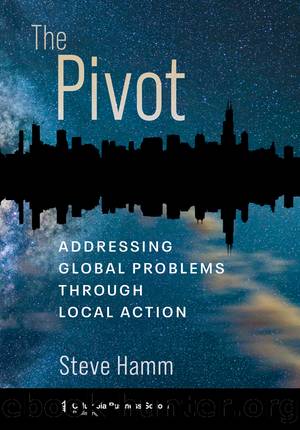The Pivot by Steve Hamm

Author:Steve Hamm
Language: eng
Format: epub
Tags: BUS072000, Business & Economics/Development/Sustainable Development, POL063000, Political Science/Public Policy/Science & Technology Policy
Publisher: Columbia University Press
Published: 2021-10-26T00:00:00+00:00
How Connectedness Hurts and Helps
In our modern world, the fundamental nature of contagions has changed. Thatâs primarily because the people and places on Earth are much more tightly connected to one another than in the past and because humans and nature are impinging on each other like never before. Weâre destroying nature at a rapid clip and it is returning the favor.
Roll back in time to 1665, the year in which the bubonic plague returned to London for the last time. It killed more than one-third of the population; at the tail end of it, the city caught fire and two-thirds of the buildings were destroyed. It was a terrible couple of years for London, but the pain was contained pretty much to a tiny (by todayâs standards) cluster of people and thatch-roof buildings on the banks of the Thames. Granted, the plague had originally spread from China across Asia and to Europe, and it was a global phenomenon, but it moved gradually along the ancient trade routes. London bounced back. So did other places where populations had been crushed by the plague.
Today, our connectedness is a double-edged sword. We live in a globally integrated society. Because the worldâs airlines carry about 3 billion passengers in an average year, air travel moves infectious diseases around the world the way the human bloodstream spreads pathogens in the body. The spread of pollution and carbon dioxide is also global. Smokestack ash produced in northern China makes a beeline to the skies of Montana, and chlorofluorocarbons released in California poke holes in the ozone layer above the South Pole. And we all share the ravages of climate change, of course. Thereâs a societal element, too. Because of social media and social networking, lies and propaganda created by politicians, their allies, and state actors spread faster, more broadly, and more effectively than ever beforeâthreatening society with the viruses of ignorance and confusion.
In other ways, though, our connectedness can help promote resilience. The internet and digital communication technologies and cloud computing enabled healthcare leaders to share information more easily about the spread of the coronavirus and to collaborate to create vaccines. Ready access to information from the United Nations and other responsible sources helps national leaders, mayors of cities, and individuals alike size up risks, spot emerging threats, and recover from disasters, both natural and humanmade. Just as connecting more people to one another via communications networks enables the rapid spread of bad information and opinions, it can also be used to spread scientific evidence, information describing solutions to environmental problems, and compelling visions of a more resilient future that would benefit all.
Leaders of Pivot Projects believed that the capabilities they were assembling and putting to work could help make the world more resilient. Collaborative intelligenceâthat blend of human expertise, computer models, and a powerful artificial intelligence (AI)âwas a potent approach to solving the worldâs most vexing problems. Just like in cities, they believed, systems thinking could be put to work to help leaders and communities solve problems that span regions, countries, and the globe.
Download
This site does not store any files on its server. We only index and link to content provided by other sites. Please contact the content providers to delete copyright contents if any and email us, we'll remove relevant links or contents immediately.
Time Management Made Easy: How to Cultivate New Habits, Improve Productivity and Get Things Done by Joshua Strachan(2371)
The 7 Habits of Highly Effective People by Stephen R. Covey & Sean Covey(2164)
The Concise Laws of Human Nature by Robert Greene(1737)
Doesn't Hurt to Ask by Trey Gowdy(1566)
Primal Leadership by Daniel Goleman(1155)
Hook Point: How to Stand Out in a 3-Second World by Brendan Kane(1100)
HBR's 10 Must Reads 2021 by unknow(1051)
Don't Sweat the Small Stuff...and It's All Small Stuff by Richard Carlson(1028)
Amazon Unbound by Brad Stone(988)
100 Things Successful People Do by Nigel Cumberland(971)
HBR's 10 Must Reads 2021 by Harvard Business Review(963)
The Job Closer by Steve Dalton(945)
Master of One by Jordan Raynor(940)
Lives of the Stoics by Ryan Holiday & Stephen Hanselman(905)
Declutter Your Mind: A step by step guide to learn to control your thoughts, stop worrying, relieve anxiety and eliminate panic attacks and negative thinking by Mia Chandler(888)
The Power of 100! by Shaun King(877)
Conflicted by Ian Leslie(807)
Coders at Work: Reflections on the craft of programming by Peter Seibel(794)
The Book of Hope by Jane Goodall(757)
